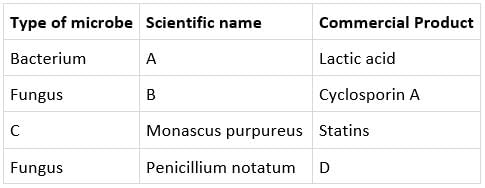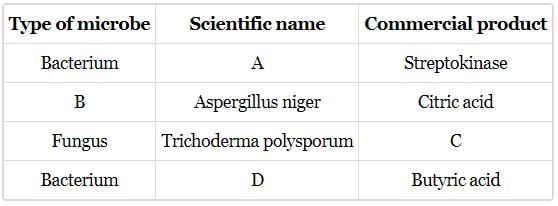Test: Microbes in Industrial Products (NCERT) - NEET MCQ
15 Questions MCQ Test Biology Class 12 - Test: Microbes in Industrial Products (NCERT)
Which of the following statements regarding antibiotics is not correct?
(i) Antibiotic is the attenuated microorganisms which in small concentrations, can kill or retard the growth of other harmful microorganisms.
(ii) Penicillin was the first antibiotic to be discovered by Alexander Fleming (1928) while working on bacterium Staphylococcus aureus.
(iii) The full potential of penicillin as an effective antibiotic was established by Ernest Chain and Howard Florey.
(iv) Fleming, Chain, and Florey were awarded the Nobel Prize in 1945.
(i) Antibiotic is the attenuated microorganisms which in small concentrations, can kill or retard the growth of other harmful microorganisms.
(ii) Penicillin was the first antibiotic to be discovered by Alexander Fleming (1928) while working on bacterium Staphylococcus aureus.
(iii) The full potential of penicillin as an effective antibiotic was established by Ernest Chain and Howard Florey.
(iv) Fleming, Chain, and Florey were awarded the Nobel Prize in 1945.
Which of the following antibiotics was extensively used to treat American soldiers wounded in World War II?
Which of the following antibiotics is not correctly matched with the source from which it is obtained?
______ produced by bacterium Streptococcus and modified by genetic engineering is used as a clot buster for removing clots from the blood vessels of patients who have undergone myocardial infarction leading to heart attack.
Select the correct option to fill up the blanks.
(i) ___________are used in detergent formulations and are helpful in removing oily stains from the laundry.
(ii) _____________are ripened by growing Penicillium roqueforti on them.
(iii) ___________are produced without distillation whereas,__________are produced by distillation of the fermented broth.
(iv) ___________antibiotic was used to teat American soldiers wounded in world war II.
(v) _______is also called as Kusht rog.
Which of the following options contains the end products formed during anaerobic respiration in Yeast?
Which of the following organisms is used in the production of beverages?
A drug used for patient A is obtained from the organism B. Identify A and B in the above statement and select the correct answer.
Which of the following antibiotics is used to cure throat infections?
Identify the blank spaces A, B, C and D in the following table and select the correct answer.

Stains used for lowering blood cholesterol level are extracted from
Wine and beer are produced directly by fermentation. Brandy and whisky require both fermentation and distillation. This is because
Identify the blank spaces A, B, C and D in the following table and select the correct answer.

Identify the blank spaces A, B, C and D in the table given below and select the correct answer.

|
78 videos|277 docs|174 tests
|



















